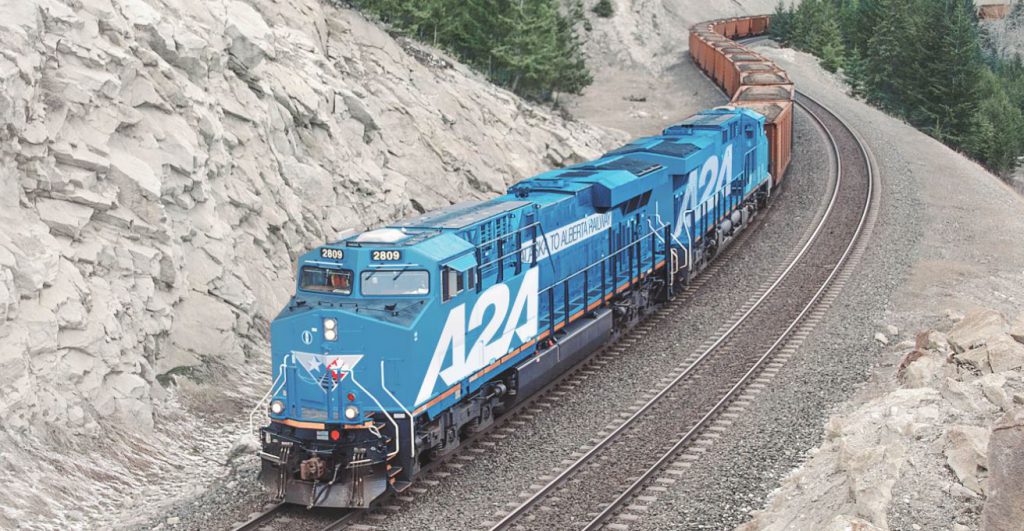Trump signs off on Alberta to Alaska railway proposal

By Bruce Lantz
Those searching for good news in the oil and gas sector were buoyed recently with an announcement that moved a proposed railroad from Alberta to Alaska closer to reality.
U.S. President Donald Trump has issued a presidential permit authorizing a CAD$22-billion (US$17 billion) freight railway line from Fort McMurray, Alberta to Alaska’s Delta Junction and then link with an existing line to ports near Anchorage as well as existing Canadian rail systems. The permit gives the company permission to build and maintain rail facilities at the U.S.-Canada border.
The Alaska-Alberta Railway Development Corporation (A2A Rail) project, first proposed in 2015 by Canadian infrastructure financier Sean McCoshen, who has spent more than CAD$100 million thus far on the project, would move crude from the Alberta oil sands 1,600 miles (2,570 kilometres) to the Alaskan coast and to Asian markets, as well as transporting freight in the other direction. The proposal calls for the railway to be privately funded and privately owned.
“Industry relies on all forms of transportation, including rail, and supports efforts to increase market access for Canadian natural gas and oil,” said Ben Brunnen, vice-president for oil sands, fiscal and economic policy for the Canadian Association of Petroleum Producers (CAPP).
“Rail has played an essential role for industry in reaching existing markets, particularly given the lack of adequate pipeline capacity. Greater market access shows investors that there is a path to growth, which is an important factor in attracting investment back to Canada’s natural gas and oil industry.”
The project, which proponents say would create 18,000 jobs for Canadian workers and bring $60 billion to Canada’s GDP, is not yet a certainty. Environmental assessments have not yet been completed at the federal, provincial or territorial levels, and such reviews and land acquisition also must be completed in the U.S. before the railroad can become a reality. But the development corporation said in July that it had hired an engineering firm to begin surveying work along the proposed Alberta segment of the route. The company says it plans to begin field activities such as land clearing, fencing and access road preparation in the province in the next 3-6 months.

“This is a world-class infrastructure project that will generate . . . jobs for Canadian workers at a time when they are most needed, provide a new, more efficient route for trans-Pacific shipping and thereby link Alberta to world markets,” said McCoshen in a news release. “The new rail line will create new economic development opportunities for a wide range of businesses, communities and Indigenous communities in Canada and Alaska. We estimate that A2A Rail could unlock CAD$60 billion in additional cumulative GDP through 2040 and lift household incomes by an average of 40% in the communities we pass through in Northwestern Canada and Alaska.”
The U.S. has jurisdiction over just a small portion, about one-eighth, of the proposed railroad, a section running from Fairbanks to the Yukon border. Canadian authorities control the rest, which would cross the Yukon and the southern border of the Northwest Territories before heading into Alberta and Fort McMurray.
“A2A Rail was formed in 2015 to create a powerhouse of knowledge in railway operations and construction, infrastructure financing, and Indigenous peoples engagement and relations, to actualize this project and be a long-term partner in the U.S. and Canada,” McCoshen said. “This project enables unprecedented economic opportunities for all stakeholders involved and provides critical infrastructure for millions of people in North America.”
While many are heralding this as a significant development that will give a much-needed boost to the industry, particularly in Canada, it may not be the panacea they desire. Rail has been talked about as a supplement to the often-congested pipelines designated to move Alberta crude to U.S. refineries. In point of fact, however, new pipelines now being built may reduce the urgency for other transportation options, and some are already questioning whether or not oil demand has already peaked. In addition, shipping oil by rail has led to several high-profile accidents in recent years in both Canada and the U.S., which has sparked criticism by environmental groups and others.
While A2A has said it expects construction to be complete by 2025 and the railway to be operational by 2026, next steps that include engagement with Indigenous groups, going through environmental impact assessments and obtaining the necessary regulatory approvals could well run up against Canada’s regulatory system, which has long been criticized for being too sluggish, and the company notes that pipeline projects in Canada and the U.S. have run into opposition from both environmental and Indigenous groups.
But proponents view Trump’s approval as a good sign. “The issuance of a presidential permit is a significant milestone that will greatly assist with our continued efforts to build the A2A railway,” McCoshen said in a news release.
“This is a world-class infrastructure project that will generate thousands of jobs for American and Canadian workers, provide a new, more efficient route for trans-Pacific shipping and link Alaska to North American transportation networks.”
